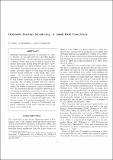| dc.contributor.author | Seher, T. | |
| dc.contributor.author | Rondenay, Stephane | |
| dc.contributor.author | Djikpesse, H. | |
| dc.contributor.other | Massachusetts Institute of Technology. Earth Resources Laboratory | |
| dc.date.accessioned | 2014-09-30T12:01:34Z | |
| dc.date.available | 2014-09-30T12:01:34Z | |
| dc.date.issued | 2011 | |
| dc.identifier.uri | http://hdl.handle.net/1721.1/90450 | |
| dc.description.abstract | Hydraulic fracturing involves the injection of a fluid to fracture oil and gas reservoirs, and thus increase their permeability. The process creates numerous microseismic events, which can be used to monitor subsurface operations. In this study we introduce a novel microearthquake relocation workflow based on crosswell seismic observations and in-situ velocity measurements, and then apply it to data from two hydraulic fracture stages conducted at the Jonah field (Wyoming). The relocation is carried out by global optimization of a probability density function including P- and S-wave traveltimes, as well as source-receiver azimuths. By averaging multiple cross-well observations, we reorient the three component receivers and reduce the scatter of measured azimuth values by 50-60%. By simultaneously relocating the observed microearthquake ensemble for one fracture stage, we derive a more reliable image of the average fracture orientation and reduce the scatter of microearthquake locations by 20-40% as compared to conventional approaches. For the two stages of fracturing investigated, the microearthquakes are found to follow a NW-SE trend that places constraints on the local stress field and on the newly created fluid paths. | en_US |
| dc.description.sponsorship | Massachusetts Institute of Technology. Earth Resources Laboratory; Schlumberger-Doll Research Center | en_US |
| dc.language.iso | en_US | en_US |
| dc.publisher | Massachusetts Institute of Technology. Earth Resources Laboratory | en_US |
| dc.relation.ispartofseries | Earth Resources Laboratory Industry Consortia Annual Report;2011-13 | |
| dc.subject | Fractures | |
| dc.subject | Microseismic | |
| dc.title | Hydraulic Fracture Monitoring: A Jonah Field Case Study | en_US |
| dc.type | Technical Report | en_US |
